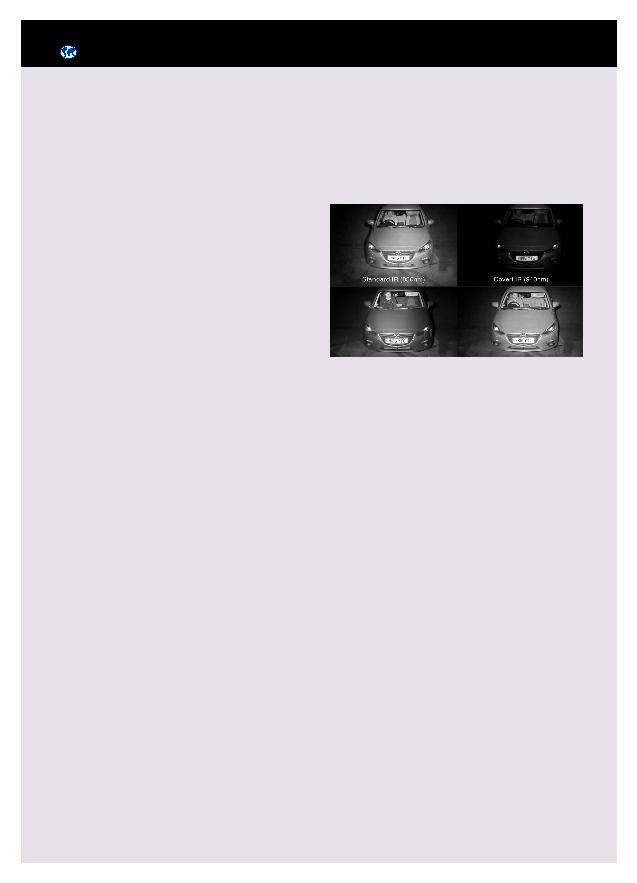
1 8 · d e t e k t o r i n t e r n a t i o n a l
ANPR (also called LPR , Licence
Plate Recognition) is used to
automatically capture the details
of a vehicle's number plate for car
park or toll road access, monitor-
ing driver speed, as well as tackling
travelling criminals, and generally
disrupting crime on our roads.
Dedicated, high-quality illumina-
tion plays a vital role in enabling
the ANPR system to effectively
capture the plate.
However, when looking over
lighting requirements for ANPR,
it's essential to take a system-wide
approach and consider all aspects
that affect image capture.
Wavelength
Callum Ryder at Raytec, empha-
sises that one of the first consid-
erations is the type, or wavelength,
of light that is required for the
system.
"Most ANPR systems tend to
use 850nm infrared (IR). IR pro-
vides the best results for capturing
images of the vehicle's plate, and
aside from a faint red glow from
the illuminator, there is also zero
visible light which limits the pos-
sibility of distracting the driver."
With many ANPR systems,
visible light is filtered out and only
IR light is used by the camera.
"This is done to help overcome
some of the challenges of captur-
ing the plate, such as dirt and
problems with glare on the plates
from headlights, sunlight, or wet
roads," states Callum Ryder.
"In some rare cases, the colour
of the plate may need to be identi-
fied. In these instances, white-light
could be deployed. However, given
that white-light is highly visible
to the human eye, it may limit its
suitability to many ITS (Intel-
ligent Transport System) applica-
tions," he explains further.
A wavelength of 730nm, or
far-red, is also becoming more
popular in ITS applications. How-
ever, 730nm tends to have a more
specific use for seeing through
the windscreen of a vehicle, to
identify occupants within. If the
sole objective is to capture the
vehicles' plate, then 730nm would
generally not be required.
Constant vs. pulsed
When designing an ANPR system,
you can either use constant or
pulsed light. Constant illumina-
tion is when a light is switched
on 100% of the time, usually due
to a specific user requirement,
where they want the light to be
constantly available. Pulsed illumi-
nation refers to fast flashes of light
that sync directly with the camera's
shutter. Using pulsed lighting
provides on-demand lighting to
accurately record imagery of fast-
moving objects. The illuminator
can be synced with the camera's
shutter via a digital input to ensure
there are maximum levels of light
when required.
Pulsed lighting offers several
advantages over constant illumina-
tion, most notably delivering a
significant increase in power. This
is crucial for ANPR applications
capturing fast-moving vehicles.
The faster the vehicle is travelling,
the faster the shutter speed of the
camera must be, and the more
light is required (the faster shutter
allows less usable light to pass to
the camera sensor).
Using a higher f-stop, or a nar-
row band pass filter, can further
restrict the amount of light to
the camera and places further
importance on using additional,
purpose-designed lighting. How-
ever, pulsed light is not necessarily
required for all ANPR systems.
For those capturing the vehicles'
plate at low speeds, or while the
vehicle is stationary (such as car
park entry systems), a constant
light illuminator could provide
ample levels of power.
Control & Communication
An illuminator being used as
part of an ANPR system will
often be integrated with other
devices, such as the ANPR cam-
era. Therefore, it's important to
consider how the illuminator can
be controlled, and how it can
communicate with other devices
in the system.
For more complex ANPR sys-
tems, Callum Ryder suggests an
illuminator that is IP enabled so it
can be connected to other devices
via an ethernet connection.
"This will allow the illumina-
tor to communicate with other
devices on the network and means
it can be controlled remotely in
real-time."
Adjustable Pulse Settings
If light is being pulsed within the
ANPR system, it's also important
for the user to be able to control
and adjust the pulse settings of
the illuminator. Among other
criteria, the length, frequency, and
intensity of the pulse can all be
adjusted and fine-tuned for the re-
quirements of the application. For
example, vehicles travelling at high
speeds will generally require the
camera to utilise a faster shutter
speed, which in turn could mean a
narrower pulse width, and higher
intensity is required compared to
a system capturing vehicles travel-
ling at slower speeds.
It should be possible to control
the illuminator through its own
internal web pages, or GUI
(Graphical User Interface). The
level of control which is possible
through the GUI, and its ease
of use, is an important factor to
consider when specifying an il-
luminator for an ANPR project.
Multipulse function
Raytec's Pulsestar VTR and VCT
illuminators also offer a `multi-
pulse' function which can be use-
ful in ANPR applications where
vehicles are passing at different
speeds.
"With the multipulse function
enabled, once the illuminator
receives a trigger it can deliver up
to five subsequent pulses, at dif-
ferent pulse lengths. This provides
five separate images to increase
the chance of obtaining the best
possible quality image," concludes
Callum Ryder.
Raytec are world leaders in LED lighting for safety
and security. In this article Callum Ryder, product
manager at Raytec, gives his views on lighting re-
quirements for ANPR (Automatic Number Plate Rec-
ognition).
Special Feature: Intelligent Security Systems
Lighting for ANPR what to think about
With many ANPR systems, visible light is filtered out and only IR light is used by the
camera.
Callum Ryder, Product Manager, Raytec:
